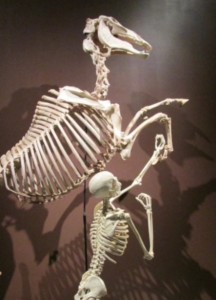Editor’s Note: Beasts of Being is a four-part essay dedicated to examining the evolution of the horse-human connection. It’s an umbrella idea for making horses newly relevant and recognized in the 21st century. The concept was first introduced at a weekend trail riding gathering of the Back Country Horsemen of Utah in 2015. Many thanks for their BCHU speaking invitation. Watch Beasts of Being video.
By Maddy Butcher
Some 5,500 years ago in Kazakhstan, there was light bulb moment when man looked at equus caballus and thought, ‘Hey, I can ride that thing.”
 Since then, we’ve fought wars and built worlds on horses’ backs.
Since then, we’ve fought wars and built worlds on horses’ backs.
Fast forward to the beginning of the 20th century; Americans have 20 million horses. Every family, on average, has more than one. Folks start and end their days on horseback or on a horse- drawn wagon. For the bulk of its early growth, this country was built and was made categorically better because of horses.
Nearly every American town has vestiges of those horse lives. But carriage houses, hitching posts, and post roads have become unremarkable remarks in travel guides. Though they are lauded as American icons and preserved in memes and brands, horses have lost their relevance in every day function. They are expendable. (Just ask the Unwanted Horse Coalition, in Washington D.C., which estimates that 170,000 horses become “unwanted” every year.)
Horses are disappearing from the world as beasts of burden. They’re still here, of course. But fewer and fewer of them have jobs. If you were to follow a logical course, you’d put horses in museums and zoos.
 Horses are already there. The American Museum of Natural History produced The Horse exhibit eight years ago and it’s now touring the country. At the Hogle Zoo in Salt Lake City, horses are on display. Okay, they’re mustangs. But we know that mustangs are domestic horses turned loose from their jobs awhile back.
Horses are already there. The American Museum of Natural History produced The Horse exhibit eight years ago and it’s now touring the country. At the Hogle Zoo in Salt Lake City, horses are on display. Okay, they’re mustangs. But we know that mustangs are domestic horses turned loose from their jobs awhile back.
There are about four million horses in the US now. In the last century, we’ve made mammoth technological and societal advances. We get places faster. We do things more quickly. Yet, we are not categorically healthier and happier. Research shows what we’ve been shedding is valuable, even essential to our well being. These elements cannot be replaced by rapid transit, lightning fast Internet connections, or thoughtful operating systems.
Time outside. Time with animals. They are key factors in a crafting a vibrant life.
 Research shows horses may be the most effective ‘feel good’ animals. Indeed, the number of horse-related therapeutic centers is steadily increasing. This burgeoning community is helping to successfully repurpose horses from beasts of burden to Beasts of Being.
Research shows horses may be the most effective ‘feel good’ animals. Indeed, the number of horse-related therapeutic centers is steadily increasing. This burgeoning community is helping to successfully repurpose horses from beasts of burden to Beasts of Being.
What we horse owners know as horse time is being rebranded as equine therapy, equine-assisted learning, equine-facilitated therapy, etc. These various entities have discovered what we’ve always known, but perhaps taken for granted:
Hanging around horses makes you feel good.
There are two reasons why this is so…
Read Beasts of Being, II, next week.